The Alif-Ba: A Manuscript of the Arabic Alphabet
Regular price $34.95This piece fits beautifully anywhere, whether it be a living room, nursery, office, or school.
Lavishly illuminated, this Ottoman manuscript was designed for a student to learn to read Arabic, It’s illumination is in the Ottoman Baroque style, which mixes European and traditional Islamic influences. Purposefully and creatively assimilated, the style’s cross-cultural borrowings were combined with Byzantine references that asserted the Ottomans’ entitlement to the Classical artistic heritage of Europe.
The original manuscript was inaccessible, so we worked with an artist to recreate and recolor the alphabet. We are happy to remaster this piece for all to enjoy and dwell on this beautiful and sacred alphabet.
The top du’a, ‘rabbi yassirli wa la tu'assir’ meaning ‘Oh Lord, ease [my task] and make it not difficult’ was customarily written on many reading and calligraphy manuals from the time.
May Allah allow us to appreciate the Arabic language and its secrets.
Paper: Archival Quality Giclee Print
Size: 11" x 14"
Illumination: Alena Samorodova
Calligraphy: Josh Berer
Art Direction: Nushmia Khan
More about the Alif-Ba:
Muslim civilization has always deeply revered the mighty stature of the Arabic alphabet and language. God states unequivocally in His Book: “Indeed, We have sent it down as a Qur'an in Arabic in order that you understand.” (12:2)
What is less known though is that each letter of the Arabic alphabet has abstract and esoteric meanings in and of itself—so much so, in fact, that when recited with intentionality and presence, they yield Divine gifts and pleasures. In a hadith, the Messenger of Allah, peace and blessings be upon him, said, “Whoever recites a letter from the Book of Allah, he will receive one good deed as ten good deeds like it. I do not say that Alif Lam Mim is one “letter”, but rather Alif is a letter, Lam is a letter, and Mim is a letter.” (at-Tirmidhi)
Arabic grammarians and linguists over the centuries have written volumes on the individual letters from various angles in fields such as exegesis, tajwid, calligraphy, numerology, lettrism, and more. One famous book in the ishtiqaq genre is Ibn Jinni’s al-Khasa’is, or “Defining Characteristics” in which the author dives deep into how the letters of the Arabic language come together in trilateral root patterns to form a thick semantic web of complex and overwhelming meaning.
In several cultures, the Arabic alphabet is called the Alefbe, or Alifbasi, which is why we named this piece the Alif-Ba.
Here's how our nikahnamas are fulfilled:
1. Complete Your Order
At the time of ordering, you must fill out your preferred language, your nikah details (names, dates, location), as well as your signature line preferences.
You may view our current text options here. If you need to customize your text, please contact us. (Please note: all of our fill-in designs are pre-printed with the 'Nikah 2' text, which cannot be changed.)
All of our Qur'an verses on our site are interchangeable, you can just message us if you'd like a different Qur'an verse!
Many of our contracts allow for personalization. A proof will be sent a few days after you order, with a limit of three rounds of editing to the proof. We do not print any nikahnamas until the proof is approved.
Shipping can take 1-8 weeks depending on the nikahnama design you choose, your location, and whether you choose to exepdite your order. Please view our shipping page for more details. If interested in a rush delivery, please contact us, and we may be able to accommodate for an additional cost.
That's it! Once you receive tracking, your nikahnama should be on its way!
Nikahnama Shipping Info
Personalized Order Processing
Below are our shipping and processing times for standard Silsila deliveries. If your order is time sensitive please contact us before placing your order. We can generally ship using overnight express with a small expedite fee.
Below are our shipping and processing times for standard Silsila deliveries after proof approval.| Product | US, Canada | Europe | Rest of the World |
| Ziya, Baiza Fill-In | 2 weeks | 3 weeks | 3 weeks |
| Personalized Orders | 2-3 weeks | 2-3 weeks | 4-8 weeks |
| Gold-Embellished Orders | 8 weeks | 8 weeks | 8 weeks |
Expedited Shipping
Please contact us at info@nikah-nama.com for specific delivery rates if you'd like an expedited order, please include your location and nikah date. Here are some turnaround times for expedited orders, but please check with us to confirm these turnaround times:
| Product | US, Canada | UK | Rest of the World |
| Ziya, Baiza Fill-In | 1-4 days | 4 days | 1 week |
| Personalized Orders | 5 days | 2-3 days | 1 week |
| Gold-Embellished Orders | N/A | N/A | N/A |
Now that your nikahnama is here, you’re not going to want to keep it in a mailing tube forever! Here are some tips for caring for your nikahnama on your wedding date, and beyond.
Upon receiving your nikahnama:
- Your nikahnama will likely arrive rolled in a tube, use some large heavy books to flatten it. You don’t want to have to struggle to keep it open while signing it.
- Check spelling errors on the nikahnama, and report them immediately if you see them.
- Decide who will be signing your nikahnama (And tell them to start practicing their signatures!)
- Choose your pen for signing (See our blog post here about what pens are best to use!)
On your nikah day:
- Designate one person who is in charge of transporting the nikahnama and pens, and storing it safely once it’s signed
- Keep an extra sheet of cardstock paper handy for all signatories to practice signing their signature with your pen of choice, to prevent any unwanted hiccups
- Tip: If you choose to keep your nikahnama in a frame on your wedding day, either leave the glass at home or wait to put your nikahnama back under the glass after the ink is dry. The last thing you want to do is smudge the ink.
Displaying your nikahnama at your nikah:
If you’re unable to find a readymade frame for your nikahnama, we usually recommend these two options:
- Find a readymade frame you like that is larger than the size of your nikahnama, and purchase a custom matboard that will fit your nikahnama into the exact size of your chosen frame. Here are some sites where you can purchase an inexpensive custom matboard: FrameItEasy, Matboard And More, Frame Destination, or talk to your local framer!
- The other option is to display it only in its matboard, and wait til after the nikah to have it custom framed.
We definitely recommend using an easel to display your nikahnama at your nikah!
Custom Framing your nikahnama
Custom framing provides a very finished look to your nikahnama, and also helps preserve it by keeping it in a vacuum-sealed, airtight frame. However because the frame is sealed shut, you should only custom frame your nikahnama after it’s been signed.
Here are some of the custom framing options we always recommend:
- Local framers are often the easiest and most hands-on option
- Framebridge is a site that many of our customers love!
- Level Frames
- Simply Framed
Happy signing!

















